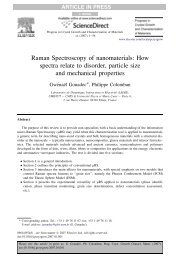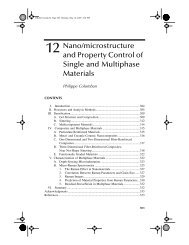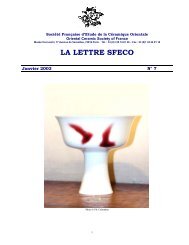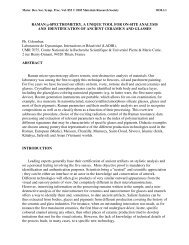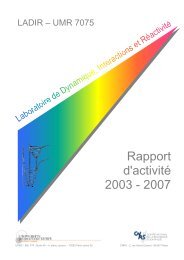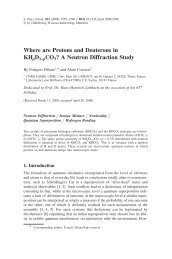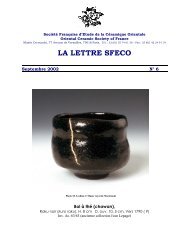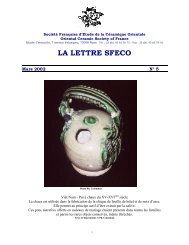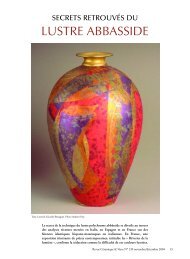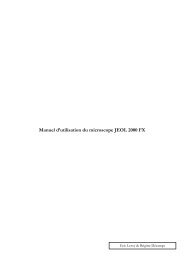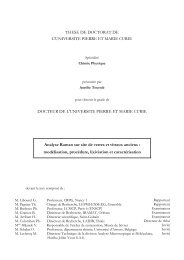Structure and dynamics of the symmetric hydrogen ... - ResearchGate
Structure and dynamics of the symmetric hydrogen ... - ResearchGate
Structure and dynamics of the symmetric hydrogen ... - ResearchGate
You also want an ePaper? Increase the reach of your titles
YUMPU automatically turns print PDFs into web optimized ePapers that Google loves.
398( )F. Fillaux et al.rChemical Physics 244 1999 387–403Ž . Ž . Ž .Fig. 9. Potential function left <strong>and</strong> wave functions right for <strong>the</strong> out-<strong>of</strong>-plane bending <strong>of</strong> <strong>the</strong> maleate ring see Table 7 .The INS b<strong>and</strong>s for <strong>the</strong> ring-deformation have nocounterparts in <strong>the</strong> infrared w21 x. Consequently, <strong>the</strong>deformations are totally <strong>symmetric</strong> <strong>and</strong> produce nodisplacement <strong>of</strong> <strong>the</strong> <strong>hydrogen</strong>-bonding proton. Thepotential function is almost unaffected by ODO sub-Table 7Žy1Calculated frequencies in cm units.<strong>and</strong> relative intensities for<strong>the</strong> out-<strong>of</strong>-plane deformation <strong>of</strong> <strong>the</strong> maleate ring. The potentialfunction is:V s51479u 2 q869expŽ y240u 2 . y600expŽ y2454u 2 .,with V <strong>and</strong> u in cm y1 <strong>and</strong> radian units, respectively. The moment<strong>of</strong> inertia is 44 amu A˚2stitution. These <strong>dynamics</strong> suggest a Cfor <strong>the</strong> <strong>hydrogen</strong> maleate.7. Discussion2vsymmetryThe potential functions presented in this work arera<strong>the</strong>r unconventional <strong>and</strong> we are not aware <strong>of</strong> anyo<strong>the</strong>r reported example. However, <strong>the</strong>se potentialsaccount very well for all <strong>the</strong> observations: frequencies,intensities <strong>and</strong> isotopic ratios. Fur<strong>the</strong>rmore, <strong>the</strong>model is consistent with neutron diffraction data.These potentials are thus likely to be physicallyrelevant.7.1. Ring <strong>dynamics</strong>The strain energy <strong>of</strong> <strong>the</strong> maleate ion in <strong>the</strong> planarcis configuration was estimated to be ;2500 cm y1Žy1;7.5 kcal mol . w15 x. The strain would be totallyrelieved ei<strong>the</strong>r by a collapse <strong>of</strong> <strong>the</strong> O PPP O distanceto that <strong>of</strong> a covalent-like bond, with an O PPP Odistance <strong>of</strong> ;1.47 A, ˚ or a rotation <strong>of</strong> ;"458 <strong>of</strong> acarboxylate group about <strong>the</strong> C–C bond. ŽThe Oatoms would be <strong>the</strong>n located at "0.85 A˚<strong>of</strong>f <strong>the</strong>mid-plane. . This strained planar geometry is stabilisedby <strong>hydrogen</strong> bonding. Crystal stacking is <strong>of</strong>little importance since <strong>the</strong> maleate ring remains esw18x. The triple minimumsentially planar in solutionpotential for <strong>the</strong> out-<strong>of</strong>-plane bending <strong>of</strong> <strong>the</strong> ring



